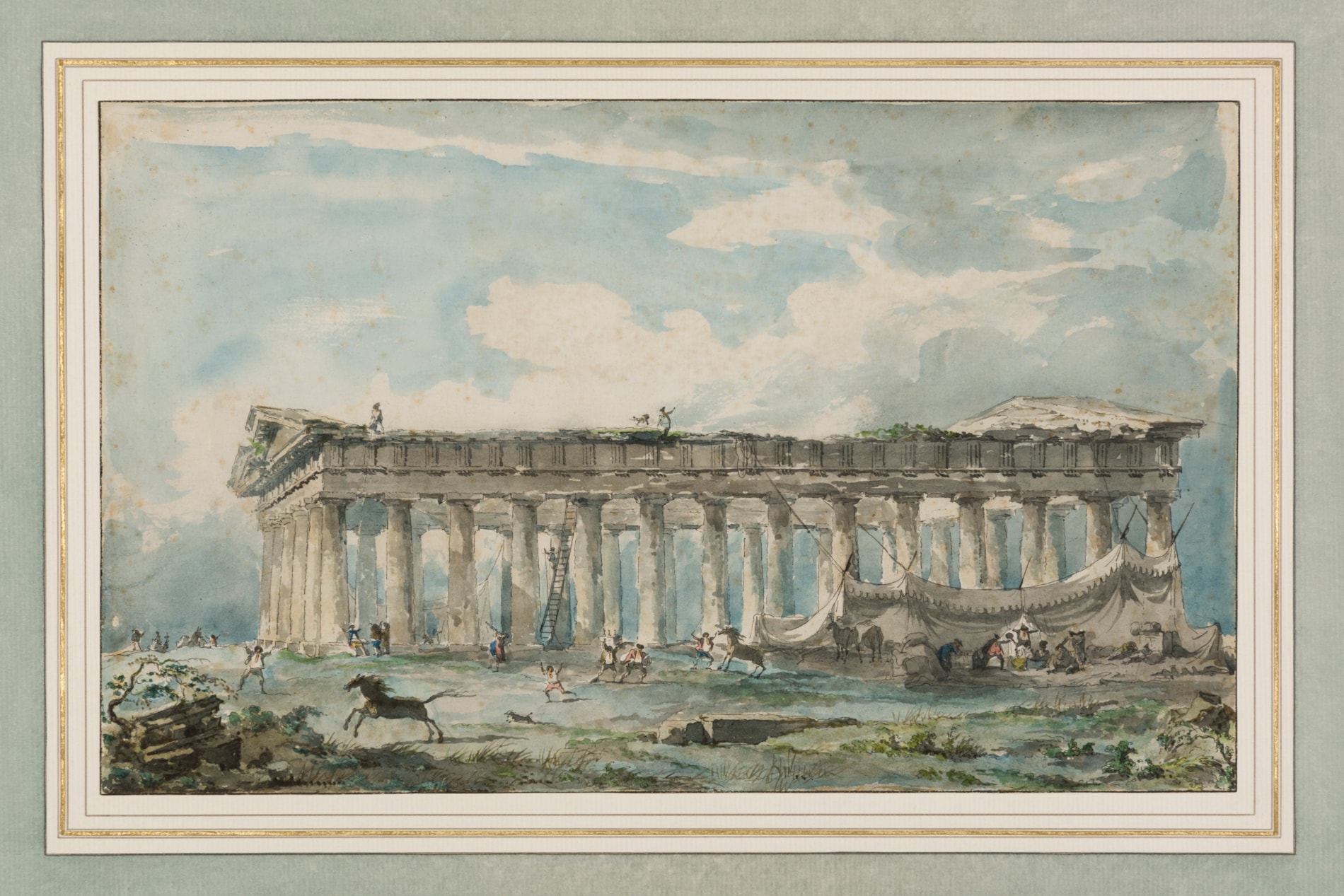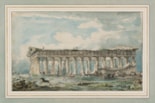Louis-Jean DESPREZ
(Auxerre 1743 - Stockholm 1804)
The Temple of Segesta in Sicily
Sold
Pen and grey ink and watercolour, with framing lines in black ink.
209 x 343 mm. (8 1/4 x 13 1/2 in.)
209 x 343 mm. (8 1/4 x 13 1/2 in.)
This is a preparatory drawing for an engraved illustration in the Abbé de Saint-Non’s lavish Voyage pittoresque, ou description des royaumes de Naples et de Sicile. Published in Paris between 1781 and 1786, the five volumes of the Voyage pittoresquemust rank as one of the finest books of the 18th century. With a text by Dominique-Vivant Denon and illustrations by Desprez, Châtelet, Hubert Robert, Jean-Honoré Fragonard, Jean-Pierre Houel and Pierre-Adrien Pâris, among others, the book was the most complete survey of the sights, customs and cultural traditions of southern Italy that had appeared up to that time. Desprez drew a total of 136 watercolour illustrations for the Voyage pittoresqueand was, alongside Châtelet, the most significant artistic contributor to the volumes.
Desprez, Châtelet and Vivant Denon spent a total of six months in Sicily, between June and November 1788, and Desprez probably visited Segesta sometime in July or August of that year. The Doric temple at Segesta, near the western tip of Sicily, is thought to have been built around 417 BC, and is one of the finest surviving examples of a Hellenistic temple. Placed on a hilltop outside the ancient Elymian city of Segesta, the temple stands in splendid isolation and is visible for miles around. Although it is unusually well preserved today, the temple appears never to have been fully completed, since it lacks a roof, an altar, and any painted or sculpted ornamentation.
The engraving after the present watercolour, executed by the artist and printmaker Jean Duplessis-Bertaux, appeared in the fourth volume of the Voyage pittoresque, published in 1783, with the caption ‘Petite vue Laterale du Temple de Segeste’. A preparatory sheet by Desprez of pen and ink sketches of the temple at Segesta is in the Nationalmuseum in Stockholm. The artist also produced a watercolour of the interior of the temple at Segesta for the Voyage pittoresque, which is now in the collection of the Albertina in Vienna.
Among stylistically comparable watercolour drawings by Desprez for the Voyage pittoresque are several views of the temples at Agrigento in Sicily, including The Ruins of the Temple of Juno Lacinia at Agrigento in the Musée Fabre in Montpellier and The Ruins of the Temple of Hercules at Agrigento in the Victoria and Albert Museum in London, as well as two views of The Temple of Concordia at Agrigento formerly in the Stevens collection in Dover. Other watercolour drawings by Desprez for the Voyage pittoresque are in the Musée des Beaux-Arts et d’Archéologie in Besançon, the Metropolitan Museum of Art in New York, the Nationalmuseum in Stockholm, the National Gallery of Art in Washington, DC, and elsewhere.
As Pierre Rosenberg has noted of another of Desprez’s watercolour drawings for the Voyage pittoresque, in terms equally applicable to the present sheet, ‘The humour and vivacity of his observation, and his imagination, make the drawing something more than just an exact topographical record.’ Similarly, as Mary Tavener Holmes has recently commented, ‘Desprez, an architect with a talent for set design and an interest in classical antiquity…was a logical choice to provide drawings for the abbé de Saint-Non’s Voyage pittoresque…While Desprez may have been approached initially as an architect, it was his scenographic talents that prevailed. Far from being dry schematic renditions, his scenes are alive with action, the small figures (so reminiscent of the work of Jacques Callot, which he must surely have known) expressive and energetic.’
Desprez, Châtelet and Vivant Denon spent a total of six months in Sicily, between June and November 1788, and Desprez probably visited Segesta sometime in July or August of that year. The Doric temple at Segesta, near the western tip of Sicily, is thought to have been built around 417 BC, and is one of the finest surviving examples of a Hellenistic temple. Placed on a hilltop outside the ancient Elymian city of Segesta, the temple stands in splendid isolation and is visible for miles around. Although it is unusually well preserved today, the temple appears never to have been fully completed, since it lacks a roof, an altar, and any painted or sculpted ornamentation.
The engraving after the present watercolour, executed by the artist and printmaker Jean Duplessis-Bertaux, appeared in the fourth volume of the Voyage pittoresque, published in 1783, with the caption ‘Petite vue Laterale du Temple de Segeste’. A preparatory sheet by Desprez of pen and ink sketches of the temple at Segesta is in the Nationalmuseum in Stockholm. The artist also produced a watercolour of the interior of the temple at Segesta for the Voyage pittoresque, which is now in the collection of the Albertina in Vienna.
Among stylistically comparable watercolour drawings by Desprez for the Voyage pittoresque are several views of the temples at Agrigento in Sicily, including The Ruins of the Temple of Juno Lacinia at Agrigento in the Musée Fabre in Montpellier and The Ruins of the Temple of Hercules at Agrigento in the Victoria and Albert Museum in London, as well as two views of The Temple of Concordia at Agrigento formerly in the Stevens collection in Dover. Other watercolour drawings by Desprez for the Voyage pittoresque are in the Musée des Beaux-Arts et d’Archéologie in Besançon, the Metropolitan Museum of Art in New York, the Nationalmuseum in Stockholm, the National Gallery of Art in Washington, DC, and elsewhere.
As Pierre Rosenberg has noted of another of Desprez’s watercolour drawings for the Voyage pittoresque, in terms equally applicable to the present sheet, ‘The humour and vivacity of his observation, and his imagination, make the drawing something more than just an exact topographical record.’ Similarly, as Mary Tavener Holmes has recently commented, ‘Desprez, an architect with a talent for set design and an interest in classical antiquity…was a logical choice to provide drawings for the abbé de Saint-Non’s Voyage pittoresque…While Desprez may have been approached initially as an architect, it was his scenographic talents that prevailed. Far from being dry schematic renditions, his scenes are alive with action, the small figures (so reminiscent of the work of Jacques Callot, which he must surely have known) expressive and energetic.’
Following an apprenticeship with Charles-Nicolas Cochin, Louis-Jean Desprez was admitted into the Académie Royale d’Architecture in Paris in 1765. He frequently entered the architectural competitions held at the Académie, submitting large, highly finished pen drawings. While he studied architecture for several years, he also took up studies in drawing and engraving, eventually being appointed a Professor of Drawing at the Ecole Royale Militaire. Desprez was to spend almost all of his independent career outside France, however. In 1776 he won the Prix de Rome in the field of architecture, although soon after his arrival in Italy he seems to have finally abandoned the study of architecture in favour of landscape drawing. This was perhaps inspired by the fact that in 1777 he was commissioned by the Abbé de Saint-Non to produce illustrations for the Voyage pittoresque, ou description des royaumes de Naples et de Sicile, published in five volumes between 1781 and 1786. Together with Claude-Louis Châtelet and Dominique-Vivant Denon, Desprez spent just over a year travelling throughout southern Italy, making numerous topographical drawings which, on his return to Rome in 1779, he often adapted as designs for engravings.
After more than four years in Rome, Desprez was summoned to Sweden in 1784 by King Gustav III, who engaged him on the design of theatrical decorations for the new Royal Opera House in Stockholm. He worked in Sweden for the rest of his career, obtaining the position of court architect and scenographer, and producing numerous stage designs for the theatres at Drottningholm and elsewhere. Buoyed by the patronage of the King, who shared with the artist a love of the theatre, Desprez enjoyed a position of some importance in Swedish artistic circles. Following the assassination of Gustav III in 1792, however, his star faded. In the hope of finding a new patron responsive to his ambitious vision, he made several drawings for the Empress Catherine II of Russia but was unsuccessful in gaining her support. He eventually died in poverty and obscurity in Stockholm.
Desprez’s watercolour drawings, sometimes of a considerable scale, reveal an artist fascinated with the dramatic possibilities of a scene. (Indeed, it was just this ability and vision that made him such a success as a theatrical designer.) Much of his surviving work as a draughtsman is today to be found in Swedish collections. The largest extant group of drawings by Desprez is today in the Nationalmuseum in Stockholm, while a significant number of theatrical designs by the artist are in the collection of the Teatermuseum at Drottningholm.
After more than four years in Rome, Desprez was summoned to Sweden in 1784 by King Gustav III, who engaged him on the design of theatrical decorations for the new Royal Opera House in Stockholm. He worked in Sweden for the rest of his career, obtaining the position of court architect and scenographer, and producing numerous stage designs for the theatres at Drottningholm and elsewhere. Buoyed by the patronage of the King, who shared with the artist a love of the theatre, Desprez enjoyed a position of some importance in Swedish artistic circles. Following the assassination of Gustav III in 1792, however, his star faded. In the hope of finding a new patron responsive to his ambitious vision, he made several drawings for the Empress Catherine II of Russia but was unsuccessful in gaining her support. He eventually died in poverty and obscurity in Stockholm.
Desprez’s watercolour drawings, sometimes of a considerable scale, reveal an artist fascinated with the dramatic possibilities of a scene. (Indeed, it was just this ability and vision that made him such a success as a theatrical designer.) Much of his surviving work as a draughtsman is today to be found in Swedish collections. The largest extant group of drawings by Desprez is today in the Nationalmuseum in Stockholm, while a significant number of theatrical designs by the artist are in the collection of the Teatermuseum at Drottningholm.
Provenance
Anonymous sale, London, Phillips, 2 July 1990, lot 105
Nicolas Joly at Galerie Yves Mikaeloff, Paris
Private collection.
Nicolas Joly at Galerie Yves Mikaeloff, Paris
Private collection.
Literature
Petra Lamers, Il Viaggio nel Sud dell’Abbé de Saint-Non: Il “Voyage pittoresque à Naples et en Sicile”: la genesi, I disegni preparatory, le incisoni, Naples, 1995, pp.267-268, no.264b, illustrated in colour p.66; Clifford S. Ackley, ‘The Intuitive Eye: Drawings and Paintings from the Collection of Horace Wood Brock’, in Horace Wood Brock, Martin P. Levy and Clifford S. Ackley, Splendor and Elegance: European Decorative Arts and Drawings from the Horace Wood Brock Collection, exhibition catalogue, Boston, 2009, p.95 and p.159, no.144, illustrated p.141; Stefano Piazza, Il viaggio di Denon in Sicilia e l’architettura templare greca, in Tommaso Manfredi, ed., Voyage Pittoresque: Esplorazioni nell’ Italia nel Sud sulle trace della spedizione Saint-Non, ArcHistoR, 2018, p.639, fig.2.
Exhibition
Stanford University, Cantor Center for Visual Arts, Classic Taste: Drawings and Decorative Arts from the Collection of Horace Brock, March-May, 2000; Los Angeles, J. Paul Getty Museum, A Revolutionary Age: Drawing in Europe 1770-1820, 2005, no.13; Boston, Museum of Fine Arts, Splendor and Elegance: European Decorative Arts and Drawings from the Horace Wood Brock Collection, 2009, no.144.





